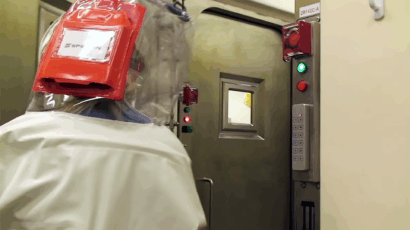Capability versus intent: The latent threat of nuclear proliferation
By Wolfgang K. H. Panofsky | June 14, 2007
The Nuclear Non-Proliferation Treaty (NPT) as well as President Dwight D. Eisenhower’s Atoms for Peace proposal made a valiant attempt to have it both ways–stem nuclear proliferation and encourage civilian nuclear power. But can this work without conflict? The answer is maybe. Only if international steps additional to the NPT are taken, can the proliferation risks inherent in the nuclear fuel cycle be minimized.
The peaceful applications of nuclear energy include steps that can greatly shorten the lead time toward acquiring nuclear weapons. These steps are enrichment of natural uranium in the isotope U-235; reprocessing of spent reactor fuel to recover plutonium; and the use of highly enriched uranium (HEU) in research reactors.
All states possessing nuclear weapons–and additionally, Brazil, Germany, Japan, and the Netherlands–have enrichment facilities, and Iran has publicized its first steps toward that end. All states possessing nuclear weapons also reprocess spent fuel; in addition, Japan, a non-nuclear weapon state, has reprocessing facilities. HEU is still a component of research reactors at about 100 sites worldwide. 1
In a technical sense, the above facilities contribute to the latency of non-nuclear weapon states in their potential to acquire nuclear weapons. But latency should be considered to be the product of such technical capability and the intent to proceed toward the acquisition of nuclear weapons.
While technical capability can be measured by performance of the facilities mentioned above, to a large extent, intent is in the eyes of the beholder. European enrichment facilities are part of URENCO, the combine which operates under strict European and International Atomic Energy Agency (IAEA) safeguards. Brazil’s program, although initially intended for military purposes, is now under bilateral monitoring by an organization cosponsored by its neighbor, Argentina, and also by the IAEA.
Japan is in a different situation: It contracted with the Europeans to reprocess its spent fuel to recover plutonium to use as mixed oxide fuel and in a breeder reactor. These latter programs have seriously lapsed so that Japan has accumulated some 40 tons of plutonium, of which about one-tenth is located in Japan, with the rest remaining in Europe.
Iran’s enrichment efforts have made news. Its technical capability is in its infancy, but growing steadily. By mid-May of 2007, eight cascades of 164 centrifuges each, as well as smaller groups, are in intermittent experimental operation fed by uranium hexafluoride from Iran’s ore processing plant; Iran has claimed “industrial capability.” Note that the steady operation of about 5,000 centrifuges of the type operated by Iran are needed to separate HEU for one nuclear weapon per year.
Thus, intent becomes of paramount importance in evaluating the latency threat of these technical developments. Aside from direct intelligence, intent can be judged by evaluating a state’s motivation for acquiring nuclear weapons, by the economic justification for the state’s peaceful nuclear power program, and by the need within the peaceful nuclear power program to maintain its own supply of enriched uranium or plutonium, as the case may be.
The United States has taken the lead in proclaiming that Iran is conducting a nuclear weapons program. Iran has disavowed this notion by issuing a fatwa, or holy edict, declaring that nuclear weapons are instruments of the devil. The IAEA has found no evidence of a nuclear weapons program but also no conclusive evidence that denies such a program’s existence. Iranian leadership in nuclear matters is divided among the bombastic President Mahmoud Ahmadinejad, the more conservative religious leadership, and Ali Larinjani, the president of the National Security Council. Indeed, since it’s surrounded by nuclear-armed entities, Iran could be motivated to acquire nuclear weapons, but intent to do so has not been established.
Japan’s intent toward acquiring nuclear weapons is officially nonexistent, but in view of the recent North Korean threat, voices within Japan urging acquisition of nuclear weapons are occasionally heard. At various times, concerned Chinese point to Japanese history in expressing doubts about the peaceful intent of the Japanese program.
The economic issues involved are complex. For instance, it is difficult for Brazil to justify its large nuclear power program in view of its abundant hydroelectric resources. In general, indigenous enrichment is difficult to justify economically for a country with only a small number of nuclear reactors. Therefore, both Brazil and Iran are proclaiming international prestige and assurance of supply as the primary motivators for their nuclear power programs, including enrichment.
Japan’s pursuit of a closed fuel cycle using reprocessed plutonium remains economically unjustifiable, but the stocks of free plutonium are a residue of earlier Japanese judgments to the contrary. In view of all the above factors, it is not surprising that opinions as to the intent of the parties in question span a large range.
This account is sketchy, of course, but the question arises: How can peaceful nuclear energy be encouraged, as it must be in view of the threat of fossil fuels to global warming, while at the same time minimizing the inherent proliferation risks? The United States is pursuing a policy of selective enforcement, meaning that Washington is attempting to prevent enrichment and reprocessing by “evil” states while ignoring similar activities by “good” states. A more enduring arrangement would internationalize enrichment and reprocessing facilities while eliminating such facilities from national control; many proposals have been promulgated toward that end. These include international ownership of enrichment and reprocessing facilities with supply guarantees given to individual states.
However, implementation of such plans has not begun, and many difficult questions remain unanswered. Even under international ownership and operation of enrichment and reprocessing, the actual plants have to be located somewhere. How can the risk of a national takeover of such plants be minimized? How can the assurance of supply of fissile materials be made with confidence when the actual physical plant is located on territories of a country whose regime appears hostile to the recipient? It will take many years of patient negotiation to sort out alternate proposals for international supply of reactor fuel and to generate confidence that such supply is indeed “assured.”
1 A recent summary of these activities can be found in the “Global Fissile Material Report 2006” issued by the International Panel onf Fissile Materials, chaired by Jose Goldemberg of Brazil and Frank Von von Hippel of Princeton University. “Global Fissile Material Report 2006,” International Panel on Fissile Materials.
Together, we make the world safer.
The Bulletin elevates expert voices above the noise. But as an independent nonprofit organization, our operations depend on the support of readers like you. Help us continue to deliver quality journalism that holds leaders accountable. Your support of our work at any level is important. In return, we promise our coverage will be understandable, influential, vigilant, solution-oriented, and fair-minded. Together we can make a difference.
Topics: Nuclear Weapons, Opinion















